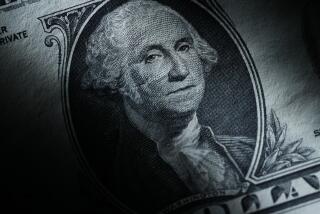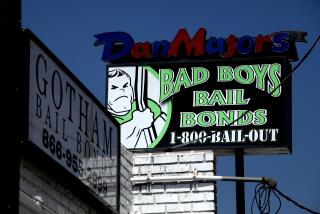‘Bad bank’ is a bad idea
The deepening recession is at least partly a product of a prolonged crisis in credit markets. Major banks have cut back on lending, unable or unwilling to part with their deposits. Even banks that have received billions of dollars in fresh capital from Washington have been slow to lend. That’s because their balance sheets, like those across the financial industry, are tainted by investments in complex securities that almost no one wants to buy, most of them tied to bundles of mortgages with rising default rates. Illiquid and losing value, these assets make it hard to judge a bank’s health. That uncertainty, in turn, makes it difficult for banks to raise money for new loans and investments.
The Bush administration sought to attack this problem in the fall with a new, $700-billion Troubled Asset Relief Program to buy the banks’ dicey holdings. It never followed through on that idea, but now the Obama administration is considering a similar approach that could be even more expensive. One plan being floated would have the government create a “bad bank” that would acquire troubled assets from commercial banks, insurance companies and segments of the credit market. The strategy is aptly named, because it’s a bad idea.
A sale without price tags
Like the original TARP, the bad-bank idea has some merit. Rather than unloading assets (which might include securitized car loans and credit card debt in addition to mortgage-related investments) at fire-sale prices, this bank would wait for markets to recover, then sell them gradually. The theory is that many of the assets have real value, which would become easier to divine over time as foreclosures ebb and the economy rebounds. Meanwhile, scraping the sludge off lenders’ books would eliminate much of the mystery about their condition, enabling credit markets to return to normal and hastening the end of the recession.
There are a couple of precedents for this approach. Mellon Bank used a bad-bank spinoff to recover from a near-death experience in the late 1980s. About the same time, Washington created the Resolution Trust Corp. to sell the questionable assets held by failing savings and loans. The RTC ended up costing taxpayers about $75 billion, a sum that looks like chump change today. And in the early 1990s, Sweden used a bad bank to clear a glut of debts from that country’s financial institutions.
The biggest problem, though, is the same one that led the Bush administration to not use the TARP as planned. As beneficial as it may be to create a market for illiquid securities, it’s well-nigh impossible to determine the right price to pay for them. They’re almost certainly worth a lot less than the value recorded on their owners’ books, but they may very well be worth more than the prices they’d command in a distress sale today. Although banks have already written down some of their holdings, analysts estimate that U.S. banks face an additional trillion dollars in losses from failing assets this year. The government could buy troubled assets in a reverse auction -- paying the price sought by the lowest bidder -- but then the most desperate players would set the price for a category of securities, forcing banks holding similar assets to make excessive and potentially disastrous write-downs. On the other hand, if the government paid the book value of the assets, taxpayers would be the ones to absorb losses that could prove to be enormous.
Then there’s the moral hazard. Even if the government managed the assets deftly enough to avert losses, most of the financial gains that resulted from the maneuvering would go to the banks that were liberated from their mistakes. Giving taxpayers a preferred stake in any institution that sells toxic assets to the government could mitigate the problem, but that might drive off investors by raising fears of a total government takeover. Just look at what’s happened to the share prices of the banks that took money from the TARP.
Doing nothing is not an option
Economists have pointed to several other ways to nurse financial markets back to health. One possibility is to have the government help launch “good banks” that could attract capital and lend money. The main drawbacks are the time it would take them to become significant players and the specter of the government picking winners and losers (not that it hasn’t been doing that already). Another idea is to have the feds take over all or part of the banking industry, wiping out shareholders. Although it solves the moral hazard problem, that would be an alarming departure from the country’s free-market system.
We think the best idea is for the government to guarantee a portion of the value of the questionable assets, rather than buying them outright. The government wouldn’t have to figure out the true worth of those securities. The guarantees would erect a floor under a bank’s holdings, making it easier for the bank to attract capital and strike deals. The weakest banks would be exposed and would likely fail; the stronger ones would endure losses before the federal guarantees kicked in, while also having to pay taxpayers for that insurance.
It’s also clear that solving the asset problem is just one piece of the puzzle. As we’ve said before, keeping more borrowers out of foreclosures is crucial because it addresses the root of the financial-market malaise. So too is stimulating the broader economy. Although the cost is daunting -- one analyst put a $3.5-trillion price tag on an asset cleanup effort -- it’s less than the impact of a banking-system breakdown. A recent study by economists Carmen M. Reinhart and Kenneth S. Rogoff found three common strains in financial crises since 1899: prolonged and deep drops in housing and stock prices; lengthy and “profound” declines in gross domestic product and jobs (with unemployment rising 7 percentage points on average); and skyrocketing government debt. Those “debt explosions” weren’t caused by bank bailouts, they wrote, but by the collapse in tax revenues caused by the downturns and the increase in government spending on stimulus programs. As discomfiting as it may be to guarantee some risky banking industry bets, the alternative is far, far worse.
More to Read
A cure for the common opinion
Get thought-provoking perspectives with our weekly newsletter.
You may occasionally receive promotional content from the Los Angeles Times.






